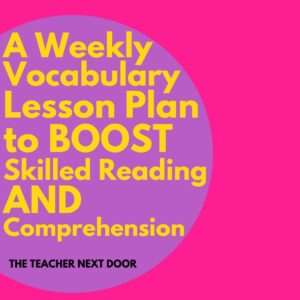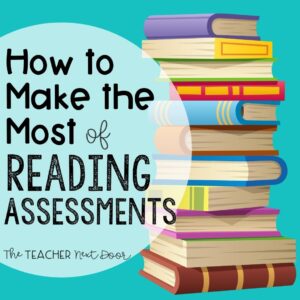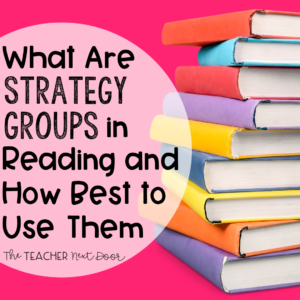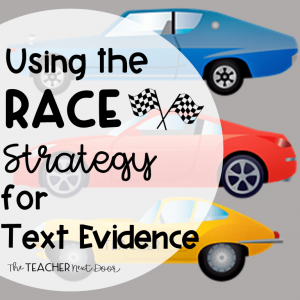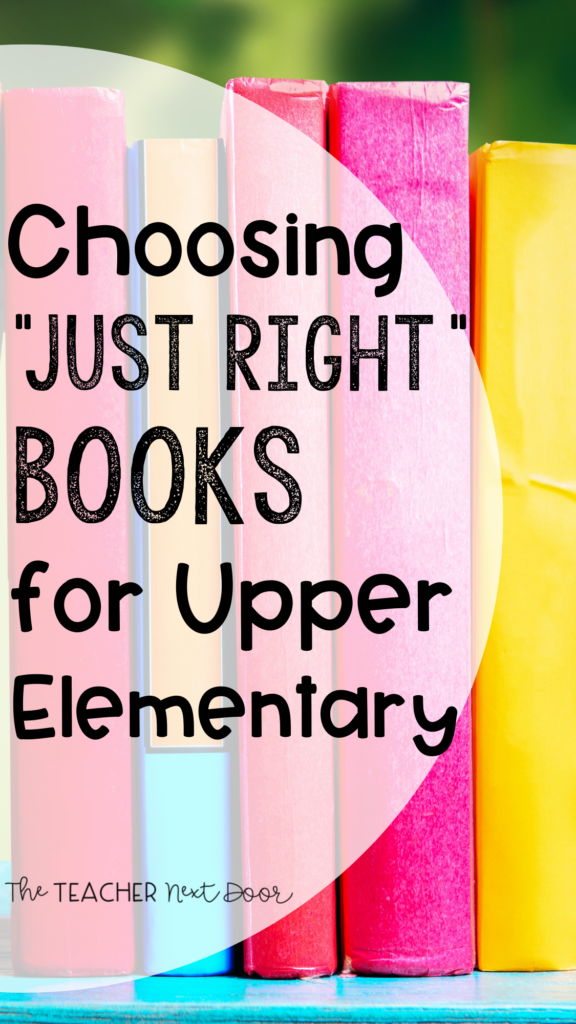
The topic of “just right” books has become big in recent years. A quick search of Pinterest or Google will bring up a plethora of anchor charts, printables, posters, mini-lessons, bulletin board ideas, and other resources about this topic.
Some believe that the best way is to have kids read books that are the exact right reading level based on assessments. These students know their own reading levels and how to find books at that level.
Other teachers are less rigid but still emphasize the need to read books that are at the perfect difficulty level. There are a lot of tricks that teachers use to make this point. The “Five-finger Rule,” or finding a book that “fits” how you would want a shoe to fit- not too big (too hard) or too small (too easy) come to mind.
Before deciding the best way to teach about finding the right book, it’s important to carefully consider what you mean when you say “just right” books.
There are so many factors that can help a student determine whether a book is a good fit. Personally, the first thing I want my students to think about is the purpose, not the difficulty level.
Don’t get me wrong, it’s definitely important that kiddos read books at the right level when they are reading to stretch themselves and grow as readers. At the same time, it is also incredibly important for students to read texts that are a little more challenging sometimes, and it also doesn’t hurt to read something that is “too easy” once in a while!
Most Important? Purpose!
The purpose is definitely the first thing I teach my students to consider. Before knowing what book you should read, you’ve got to know why you are reading it. Students need to think about whether they are reading for pleasure, reading something for the purpose of being able to complete an assignment, or simply reading to strengthen their reading skills as a whole.
Kids will choose very different books for each of these purposes, as they should!
If a student is reading an old favorite to a younger sibling or to unwind before bed, there is nothing wrong with reading something that is easy. On the other hand, when researching a new topic, some sources will be above students’ “perfect” reading level. They may need to read and reread, look up the meaning of the word, take notes, etc. When reading for this purpose, that is perfectly okay!
When reading to become a better reader, it is important to find a book at the right level. Pick one that is too easy and there will be no growth. If it’s too difficult, that’s not going to help them learn either.
We’ve got to help students understand that they need to identify their purpose and choose a book that fits.
You might be wondering what the other factors are that go into choosing a “just right” book.
Interest
Considering interest is almost as important as purpose, especially in situations where students are able to self-select books for independent reading or if they’re able to choose books to match a topic they’ve selected to research. Kids should find just-right books with topics that they are interested in, want to learn more about, or are written from a new angle that will get them thinking.
Finding a great book by looking for an author or series a student has enjoyed is another awesome way to look for books that might be a good fit. Motivation is a huge part of the process of course, but it’s important for students to know that they still need to be able to comprehend what they are reading.
Give it a Try
Once students have considered their purpose and have found a book that fits their interest, now it’s time to read the blurb on the back or inside the cover. Then students definitely need to actually read a page or two and check themselves as they read. They’ll need to evaluate the book and ask themselves some important questions like: Am I understanding the book? Is it too easy? Is it too challenging? This is the process we call monitoring comprehension (one of the reading strategies we teach).
If a lot of the words are too hard, and they can’t understand what the text says, students may want to choose a different book, buddy read it, or ask for help.
On the flip side, if it’s super easy and they sail through without giving anything a second thought, it might be a fun book to read but one that won’t necessarily stretch them as readers. Unless they are reading just for pleasure or relaxation, they might need to find a more difficult book.
Reading In The Real World
My goal as a reading teacher is to get my students ready for the real-world reading that they will need to do later in life. I firmly believe that one of the best way to do this is to help students grow as readers by selecting “just right” book for whatever purpose they’re reading.
As adults, they’ll read for lots of reasons! Sometimes they will want text that is the right difficulty level, but other times text that is more difficult or easy to read will be appropriate.
If I can help my students be metacognitive about their purpose, they can then determine what book will be “just right” for that purpose.
Interested in reading more about teaching reading? Check out the posts below!
What are Strategy Groups in Reading and How Best to Use Them
8 Reasons to Read Graphic Novels in Upper Elementary
Motivating Reluctant Readers in Upper Elementary
Thanks so much for stopping by!


